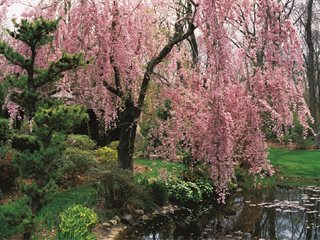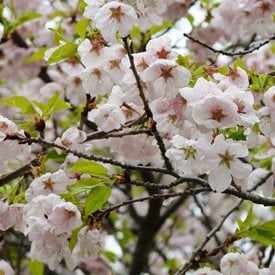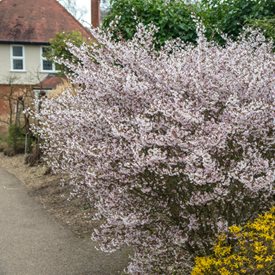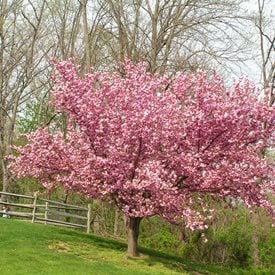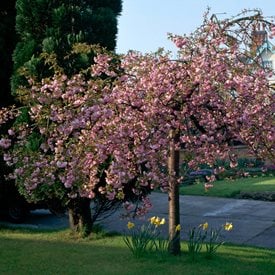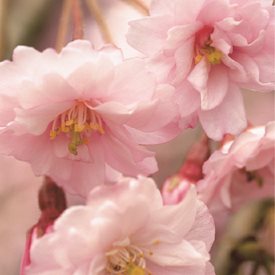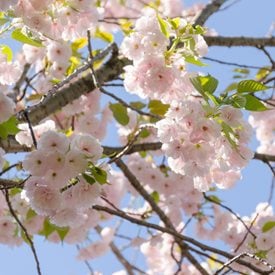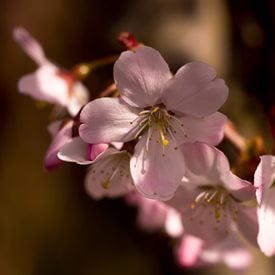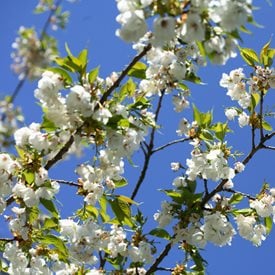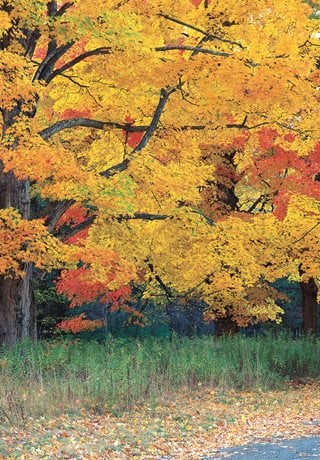Flowering Cherry Trees
Ornamental cherry trees herald the coming of spring with a profusion of pink blossomsOrnamental cherry trees are known for their explosion of showy flowers in the spring. Some types also produce small cherries in the summer that are too tart for our palettes, but appeal to a wide variety of birds. Flowering cherry trees are an excellent choice for home gardens because they require minimal care. In addition to spectacular cherry blossoms, they provide year-round color and interest with seasonally-changing foliage and attractive bark.
Zones:
5-8, 5-9 in the West
Height/Spread:
20 to 30 feet
Exposure:
Full sun
Bloom Time:
Late March through April. Temperature has a greater impact than the amount of sunlight or precipitation on bloom time. Warm, cloudy days are the best environment for coaxing early spring blooming.
Color:
Often the blossoms change colors, starting out dark pink when in bud, turning lighter pink when they first blossom, and then eventually turning pale pink or white. Some varieties also display wonderful fall color, with foliage that turns purple, red, or orange. Some varieties feature colorful bark as well.
When to plant:
Early fall is the best planting time for bare-root flowering cherry trees. Container-grown specimens can be planted in fall or after the last frost in spring.
Where to plant:
Plant in full sun for best flowering. Locate in an area with well-drained soil and away from strong winds. Flowering cherry trees should not be exposed to extreme heat or cold.
How to plant:
Dig a planting hole the same depth as the root ball or container and twice as wide. For bare root trees, the final planting depth should allow the crown of the tree or the topmost root to be level with or just above the surface. For grafted trees, be sure not to cover the grafting union.
Other:
For best results, choose a tree appropriate for your zone, preferably from a local nursery that carries varieties suited for your climate. Also make sure that you have the garden space required for your tree to mature and grow well.
Pruning:
The best time to prune is just after spring flowering. Although ornamental cherries generally require little to no pruning, branches can be thinned out for shape. This will also allow for better air circulation to help keep your tree healthy.
Soil:
Ornamental cherry trees are not demanding in regard to soil type or pH requirements, but will grow best in moderately fertile, well-drained soil.
Amendments & Fertilizer:
Ornamental cherry trees can benefit from a general purpose fertilizer applied in early spring before new growth appears.
Watering:
Water thoroughly after planting and regularly until the tree is well-established, weekly thereafter, and more often in extreme heat.
Diseases and Pests:
Like all cherry trees, ornamental flowering cherries are susceptible to insect and fungal disease problems. Many fungal diseases can be treated by application of a fungicide. Signs of disease include powdery mildew, hard knots or swelling on branches, leaf spot, and discolored or wilted leaves. Pests may include aphids, scale, borers, leafhoppers, caterpillars, Japanese beetles, and spider mites.
Other:
According to Rutgers University, flowering cherry trees are rated as “seldom severely damaged” by deer.
LANDSCAPE DESIGN TIPS
- Flowering cherry trees are quite versatile and will fit in with many garden styles including Japanese tea gardens, Asian or Zen gardens, cottage and country gardens.
- Plant a single specimen as a striking focal point in a large border, lawn area or courtyard garden.
- Use in pairs to accent either side of an entry or gateway.
- Plant in groves to make an impressive impact in a larger landscape.
- Establish in rows along driveways or streets.
- Larger varieties can provide useful shade.
- Plant spring-flowering bulbs beneath ornamental cherries for a second splash of color.
BEST FLOWERING CHERRY TREES FOR RESIDENTIAL GARDENS
BEST PLACES TO SEE CHERRY BLOSSOMS
Flowering cherry trees have long been essential to Japanese gardens, and were introduced to the United States in 1902. Since then, they’ve become almost as American as cherry pie, and are celebrated annually in many cities across the country during their spring awakening. The sight of a single spring-blooming Japanese cherry tree is pure bliss. But seeing hundreds or even thousands of them blooming en masse is a special event. Here are some cherry blossom festivals held across the country each spring:
Cherry blossom festivals:
- Washington, D.C.’s National Cherry Blossom Festival, the largest of its kind in the U.S.
- The International Cherry Blossom Festival in Macon, Georgia
- The Northern California Cherry Blossom Festival in San Francisco
- The Nashville Cherry Blossom Festival, presented by the Japan-America Society of Tennessee.
If you can’t make it to one of the above festivals, the Brooklyn Botanic Garden has a beautiful display, as well as the Missouri Botanical Gardens in St. Louis.
Enjoy garden travel? Check out our local self-guided day trips and other travel destinations. Sign up for our Garden Travel Newsletter to be alerted when new travel opportunities are available!
FLOWERING CHERRY TREE FACTS
“How can we ever lose interest in life? Spring has come again, and cherry trees bloom in the mountains.” This quote, from Japanese poet Ryokan Taigu, describes the Zen-like experience of seeing cherry trees laden with ethereal pink and white flowers each spring, a promise of the intoxicating weather to come.
Cherry tree history:
- The term “flowering cherry” refers to several species of Prunus trees and their cultivars, most originating in Japan.
- In Japan, the cherry blossom, or sakura, has been the national flower for centuries and is a symbol for the country itself.
- Flowering cherry trees have relatively short life spans of only 25 to 50 years. The Brooklyn Botanical Garden's flowering cherry collection includes some of the oldest specimens in North America, two weeping Higan cherries that were planted in 1921.
- The first Japanese flowering cherries planted in Washington, D.C. were a gift from the mayor of Tokyo.
Related:
20 Plants for Japanese GardensFlowering Trees for Residential Gardens
Spring Gardening Ideas
